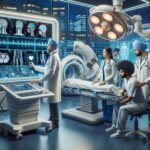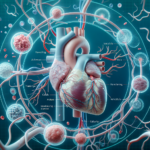Key Takeaways
- Epicardio Simulation is an innovative 3D heart simulation tool for improving cardiac care education and patient outcomes.
- It offers real-time interaction with cardiac anatomy and electrophysiology, making complex concepts easier to grasp.
- Integration with hospital systems streamlines workflows, saving time and resources.
- Hands-on experience through simulation enhances the skill set of healthcare professionals.
- Real-world case studies show significant benefits in both educational and clinical settings.
Epicardio Simulation: A Leap Forward in Hospital Technology
Imagine a world where healthcare professionals can master the complexities of the human heart without the need for invasive procedures or risk to patients. That’s exactly what Epicardio Simulation offers—a cutting-edge tool that brings the heart to life through advanced 3D simulation technology. It’s like having a virtual heart in the palm of your hand, one that beats, reacts, and allows for exploration and learning in ways that were once impossible.
What is Epicardio Simulation?
Epicardio Simulation is more than just a piece of software; it’s a gateway to a deeper understanding of cardiac anatomy and physiology. With its real-time interactive simulation, users can visualize and manipulate the heart, diving into the intricacies of its electrical activity and learning how to diagnose and manage various cardiac conditions effectively.
Core Features That Are Changing the Game
What sets Epicardio apart? It’s the blend of accessibility and depth. Here are some of its standout features:
- Real-time 3D Visualization: See the heart from any angle and watch how it responds to various conditions and treatments.
- Interactive Learning: Engage with step-by-step tutorials that cover everything from basic anatomy to complex electrophysiology.
- Accurate ECG Representation: Understand the connection between the heart’s activity and the ECG readings it produces.
These features are not just fancy bells and whistles; they’re essential tools that can help demystify one of the body’s most complex organs.
Advantages of Epicardio Simulation for Hospitals
Let’s dive into the tangible benefits that Epicardio Simulation brings to hospitals:
Enhancing Cardiac Care Training
Training with Epicardio Simulation means healthcare professionals can practice diagnosing and treating heart conditions without the pressure of a real-life situation. This hands-on experience is invaluable, allowing learners to make mistakes, understand consequences, and build confidence in a safe, controlled environment.
Improving Patient Outcomes
When healthcare providers are better trained, patient outcomes improve. By using Epicardio, clinicians can refine their skills in interpreting ECGs, understanding cardiac rhythms, and managing emergency situations, which translates to higher quality patient care.
Besides that, Epicardio’s integration into hospital systems means that all this learning can be tracked and assessed, ensuring that staff are always at the top of their game with advanced 3D cardiac surgery models.
Saving Time and Resources
One of the most significant advantages of integrating Epicardio Simulation into hospital operations is the conservation of time and resources. Consider the traditional path to cardiac proficiency—countless hours spent in lectures, poring over textbooks, and observing in clinical settings. Epicardio streamlines this process by allowing learners to engage with the material actively, reducing the learning curve and freeing up valuable resources.
Moreover, the simulation’s cloud-based nature means that updates and new learning modules can be rolled out quickly and efficiently, without the need for physical materials or extensive downtime. This agility ensures that healthcare professionals are always learning with the most current and accurate information available, such as the evolving role of Random42’s 3D animations in medical training.
Most importantly, by reducing the need for physical resources and maximizing the use of digital tools, hospitals can allocate funds to other critical areas, such as patient care or research. In the long run, the efficiency brought by Epicardio Simulation can lead to significant cost savings and a better allocation of the hospital’s budget.
Implementation Strategies for Epicardio Simulation
Implementing a new technology like Epicardio Simulation requires a strategic approach. It’s essential to ensure that the integration is smooth, with minimal disruption to existing workflows, and that all stakeholders are on board with the change.
Start by identifying a team that will lead the implementation process. This team should include IT professionals, clinical educators, and administrative staff. Together, they will map out the integration process, set timelines, and establish goals for what successful implementation looks like.
Integrating with Existing Hospital Systems
Integration is key to making Epicardio Simulation a seamless part of hospital operations. The goal is to ensure that the simulation software works in tandem with existing electronic health records (EHRs), learning management systems (LMS), and other digital tools used by the hospital. This might involve:
- Assessing compatibility with current systems.
- Working with Epicardio’s technical support to address any integration challenges.
- Setting up single sign-on capabilities for ease of access.
Training Healthcare Professionals
Once the integration is in place, focus shifts to training the healthcare professionals who will use the simulation. Effective training involves:
- Creating a structured training program with clear objectives and outcomes.
- Providing hands-on workshops and tutorials to familiarize users with the software.
- Ensuring ongoing support and refresher courses to keep skills sharp.
Real-World Success Stories
The proof of Epicardio Simulation’s value is evident in the stories of hospitals that have already implemented it. These case studies highlight not just the potential for improved learning, but also the positive impact on patient care and hospital efficiency.
Hospitals That Have Benefited from Epicardio Simulation
Hospitals around the world have reported that after integrating Epicardio Simulation, they’ve seen a marked improvement in the cardiac knowledge and confidence of their staff. In particular, teaching hospitals find that residents and fellows can quickly come up to speed on complex cardiac conditions, which is crucial in high-stakes environments.
Feedback from Medical Staff and Educators
The response from those on the front lines has been overwhelmingly positive. Clinicians appreciate the hands-on experience without the risk, while educators value the tool’s ability to convey complex concepts through visual learning. One cardiologist noted, “Epicardio has revolutionized the way we train our residents. They’re not just learning; they’re understanding.”
Overcoming Challenges in Tech Adoption
Despite its clear benefits, adopting new technology like Epicardio Simulation is not without its challenges. Resistance to change is a natural human reaction, and it’s no different within hospital settings.
Addressing the Skepticism of New Technology
To overcome skepticism, it’s important to communicate the benefits of Epicardio Simulation clearly and demonstrate its value in enhancing patient care. Involve staff in the process early, solicit their feedback, and address concerns head-on. Showcasing success stories and providing evidence of improved outcomes can also help in winning over doubters.
Overcoming Challenges in Tech Adoption
Adopting new technology like Epicardio Simulation is not without its challenges. Resistance to change is a natural human reaction, and it’s no different within hospital settings. To overcome skepticism, it’s important to communicate the benefits of Epicardio Simulation clearly and demonstrate its value in enhancing patient care. Involve staff in the process early, solicit their feedback, and address concerns head-on. Showcasing success stories and providing evidence of improved outcomes can also help in winning over doubters.
Addressing the Skepticism of New Technology
To get everyone on board with Epicardio Simulation, start by creating an open dialogue about the technology. Discuss its features, its benefits, and most importantly, the positive impact it can have on patient outcomes. Encourage questions and concerns, and address them promptly. Transparency is crucial in building trust and acceptance among the staff.
Additionally, involve a few key influencers from the medical staff who can advocate for the system’s use and effectiveness. When peers see respected colleagues endorsing the technology, they’re more likely to give it a chance.
For example, if a senior cardiologist shares a story about how Epicardio Simulation helped them to accurately diagnose a complex arrhythmia that they might have otherwise missed, it could significantly sway opinion in favor of the technology.
Navigating Financial Investment and ROI
Cost is always a concern when it comes to hospital technology. It’s essential to analyze the return on investment (ROI) that Epicardio Simulation can provide. Lay out the costs upfront, including the purchase, implementation, and training expenses. Then, compare these to the potential savings in terms of improved patient outcomes, reduced malpractice risks, and enhanced staff efficiency.
When presenting this analysis, focus on the long-term benefits. Epicardio Simulation may require an initial investment, but the enhancements in clinical skills, patient care, and overall efficiency can result in substantial savings over time.
Frequently Asked Questions
How Does Epicardio Simulation Enhance Hospital Operations?
Epicardio Simulation enhances hospital operations by providing a platform for immersive, interactive learning. It allows healthcare professionals to visualize and understand the complexities of cardiac anatomy and physiology, leading to improved diagnosis and treatment of heart conditions. This, in turn, can lead to better patient outcomes and more efficient use of hospital resources.
Is Epicardio Simulation Compatible with Other Hospital Systems?
- Electronic Health Records (EHRs): Epicardio Simulation can often be integrated with EHR systems to allow for seamless access to patient data during simulations.
- Learning Management Systems (LMS): Compatibility with LMS platforms enables tracking and assessment of staff progress and proficiency.
- Other Clinical Software: Epicardio is designed to complement other clinical tools, enhancing rather than replacing existing workflows.
Compatibility with hospital systems is a priority for Epicardio, and the company works closely with healthcare institutions to ensure smooth integration. For more insights on the importance of 3D animation in medical training, which is a key component of simulation technologies like Epicardio, explore our detailed article.
What Kind of Training is Required to Use Epicardio Simulation?
To use Epicardio Simulation effectively, healthcare professionals need to undergo a structured training program. This includes hands-on workshops, online tutorials, and ongoing support. The goal is to ensure that users are comfortable with the software and can utilize its features to the fullest extent.
Can Epicardio Simulation Be Used for Remote Learning?
Yes, Epicardio Simulation is well-suited for remote learning. Its cloud-based nature allows users to access the platform from anywhere, making it an excellent tool for distance education and teletraining. This feature is particularly useful for healthcare professionals who may not have immediate access to specialized cardiac training facilities.
What Are the Long-Term Benefits of Implementing Epicardio Simulation?
The long-term benefits of implementing Epicardio Simulation include:
- Enhanced clinical skills among healthcare professionals, leading to better patient care.
- Streamlined training processes, saving time and reducing the need for physical resources.
- Increased confidence in diagnosing and treating cardiac conditions, potentially reducing malpractice risks.
- Long-term cost savings due to improved efficiency and outcomes.
These benefits underscore the value of investing in cutting-edge simulation technology like Epicardio for hospitals looking to improve their cardiac care services.
With the healthcare industry increasingly turning to digital solutions, integrating technology into hospital operations has become paramount. One such innovation is the Epicardio Simulation, a cutting-edge tool designed to streamline cardiology training and improve patient outcomes. By utilizing advanced 3D animations, the Epicardio system offers a dynamic and interactive learning experience for medical professionals, ultimately enhancing the quality of care provided to patients.





